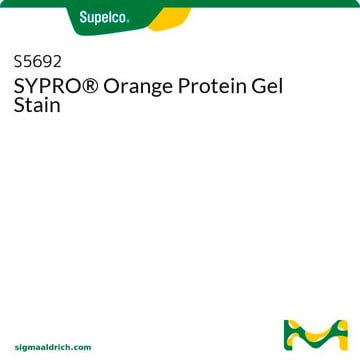Recommended Products
form
solution
storage temp.
room temp
General description
Coomassie Brilliant Blue stain is widely used for the detection of proteins in sodium dodecyl sulfate polyacrylamide gel electrophoresis (SDS PAGE). Staining with brilliant blue G is called as blue silver staining due to its improved sensitivity close to silver staining method. Coomassie Brilliant Blue G stain associates with proteins via hydrophobic interaction. It is effective in staining anterior capsule in cornea with relatively less toxic effects.
Application
Brilliant Blue G - Colloidal Concentrate has been used in the staining
- protein fragments post in vitro pepsin digestion
- ovarian tumor fluid proteome prior to profiling
- the transcription factor (TFIID) complex from Saccharomyces cerevisiae
Reconstitution
The suspension will contain 0.1% (w/v) Brilliant Blue G, 0.29 M phosphoric acid and 16% saturated ammonium sulfate after diluting to 1 liter with 800 mL water.
Analysis Note
This product has been tested for suitability on SDS-PAGE.
related product
Product No.
Description
Pricing
Signal Word
Warning
Hazard Statements
Precautionary Statements
Hazard Classifications
Eye Irrit. 2 - Met. Corr. 1 - Skin Irrit. 2
Storage Class Code
8B - Non-combustible corrosive hazardous materials
WGK
WGK 2
Flash Point(F)
Not applicable
Flash Point(C)
Not applicable
Choose from one of the most recent versions:
Already Own This Product?
Find documentation for the products that you have recently purchased in the Document Library.
Customers Also Viewed
Blue silver: a very sensitive colloidal Coomassie G-250 staining for proteome analysis
Candiano G, et al.
Electrophoresis, 25(9), 1327-1333 (2004)
Elena Barbieri et al.
Journal of aging research, 2011, 845379-845379 (2011-06-02)
This study describes mitochondrial behaviour during the C2C12 myoblast differentiation program and proposes a proteomic approach to mitochondria integrated with classical morphofunctional and biochemical analyses. Mitochondrial ultrastructure variations were determined by transmission electron microscopy; mitochondrial mass and membrane potential were
Proteomic analysis of ovarian cancer tumor fluid is a rich source of potential biomarkers
Poersch A, et al.
Journal of Proteomics and Bioinformatics, 5(2), 2-2 (2014)
A proteomic signature of ovarian cancer tumor fluid identified by highthroughput and verified by targeted proteomics
Poersch A, et al.
Journal of proteomics, 145(2), 226-236 (2016)
Purification of Active TFIID from Saccharomyces cerevisiae EXTENSIVE PROMOTER CONTACTS AND CO-ACTIVATOR FUNCTION
Auty R, et al.
The Journal of biological chemistry, 279(48), 49973-49981 (2004)
Our team of scientists has experience in all areas of research including Life Science, Material Science, Chemical Synthesis, Chromatography, Analytical and many others.
Contact Technical Service









